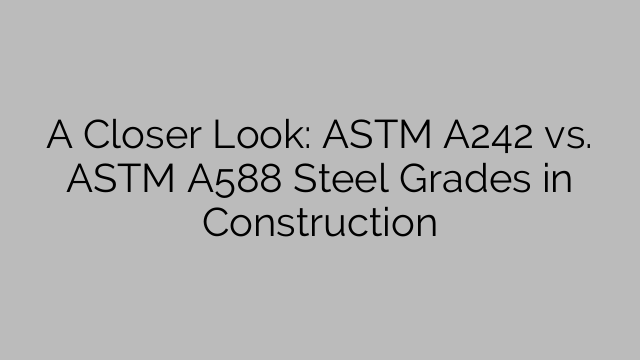ASTM A242 and ASTM A588 are two widely used steel grades in construction. Both of these materials are high-strength, low-alloy structural steels, meaning they possess excellent strength-to-weight ratios and have added corrosion resistance properties. However, there are some significant differences between the two that should be taken into consideration when selecting the appropriate steel grade for a construction project.
ASTM A242 is a high-strength, low-alloy steel grade commonly used for structural applications such as buildings and bridges. It offers atmospheric corrosion resistance and its mechanical properties allow for lighter weight constructions compared to carbon steel. This steel grade is typically used in the construction of buildings, bridges, and other structures where atmospheric corrosion resistance is required.
On the other hand, ASTM A588 is another high-strength, low-alloy steel grade but with added atmospheric corrosion resistance. This steel grade is primarily used for applications such as bridges and buildings where weight savings and durability are crucial. The addition of copper, nickel, and chromium alloy elements provides better corrosion resistance in comparison to ASTM A242, making it more suitable for outdoor and marine environments.
One of the key differences between ASTM A242 and ASTM A588 steel grades lies in their chemical composition. While both grades have trace amounts of copper, ASTM A588 specifically has higher copper content, which contributes to its enhanced corrosion resistance. Copper acts as a catalyst for the formation of a protective patina on the steel surface when exposed to air and moisture.
Another important factor to consider is the mechanical properties of each steel grade. ASTM A242 has a minimum yield strength of 50 ksi (345 MPa) and a minimum tensile strength of 70 ksi (483 MPa), while ASTM A588 has a minimum yield strength of 50 ksi (345 MPa) and a minimum tensile strength of 70 ksi (483 MPa) as well. Both grades offer high-strength properties, making them suitable for structural applications.
In terms of availability, both ASTM A242 and ASTM A588 steel grades are commonly available in various forms, including plates, bars, and beams. They can be purchased from steel suppliers or distributors, and their availability may vary depending on the size and quantity required for a particular project.
When it comes to cost, ASTM A242 and ASTM A588 steel grades are generally priced competitively. However, the cost can fluctuate depending on market conditions, supplier pricing, and the specific requirements of the project. It is advisable to consult with multiple suppliers and obtain price quotations to ensure the most economical solution.
In summary, both ASTM A242 and ASTM A588 steel grades are excellent choices for construction projects requiring high-strength, low-alloy structural steel. ASTM A242 offers good atmospheric corrosion resistance, while ASTM A588 provides enhanced corrosion resistance due to its higher copper content. The selection between the two grades ultimately depends on the specific environmental conditions and performance requirements of the project. Whichever steel grade is chosen, it is essential to ensure that it meets the necessary ASTM standards and is sourced from reputable suppliers to ensure quality and durability in construction applications.

